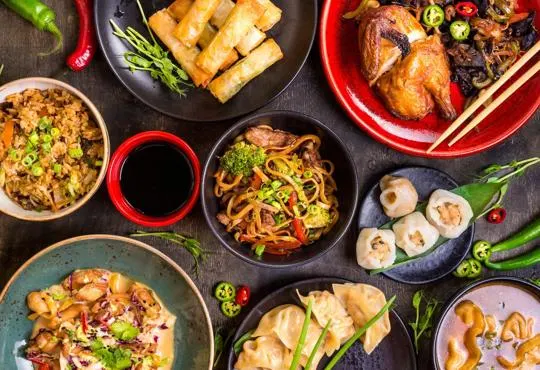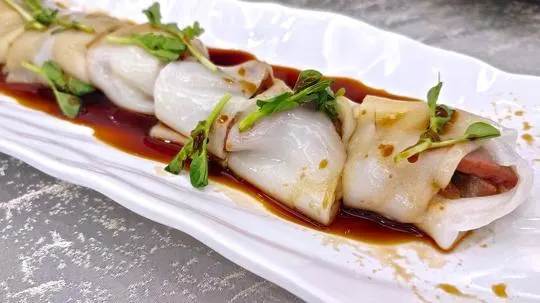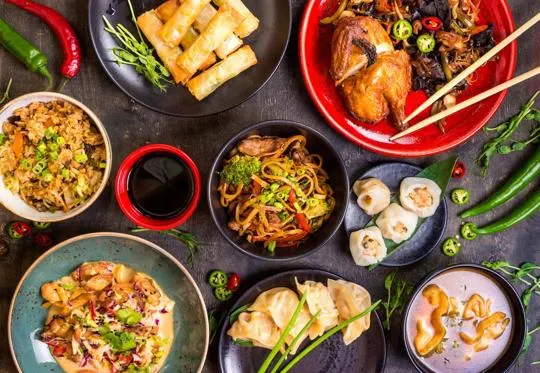Summary of key points
The main difference between Cantonese and Mandarin cuisine lies in their origins and flavors. Cantonese food originates from the Guangdong province in Southern China, known for its seafood dishes and use of fresh ingredients. The cuisine is characterized by its mild and slightly sweet taste, with a focus on preserving the natural flavors of the ingredients. On the other hand, Mandarin cuisine comes from Northern China and is known for its bold and spicy flavors, often using ingredients such as chili peppers and Szechuan peppercorns. Both cuisines offer a variety of delicious dishes, but Cantonese food tends to be more popular in Western countries due to its milder taste.
Cantonese and Mandarin dishes. Both come from China, yet they’re as different as sneakers and stilettos in a fashion lineup. Our mission? To unravel this mystery.
We’ve had our fair share of food face-offs. Picture us, poised with chopsticks, engaging in a delicious duel between these two giants. It’s not just about recipes passed down through generations.
It’s a battle of regions, ingredients, and cooking styles. Cantonese cuisine, with its sweet flavors, contrasts sharply with Mandarin’s hearty, spicier dishes.
We dived fork-first into both. Our verdict? Stay tuned.
What is Cantonese Food?

Cantonese Food hails from Guangdong, China.
It’s known for its dainty tastes and the use of fresh ingredients.
Dim sum, roasted meats, and seafood are popular dishes.
They’re prepared by stir-frying, steaming, or braising.
Unlike other Chinese cuisines, Cantonese Food keeps its natural flavors and textures.
Soup-based dishes and yummy sauces are its specialties.
With its range of flavors and cooking styles, Cantonese Food offers a truly unique dining experience.
A must-try for any foodie.
What is Mandarin Food?

Mandarin food is from the Mandarin-speaking regions of China.
It has diverse flavors and cooking techniques, with lots of ingredients.
From Peking duck to dumplings, Mandarin cuisine is popular worldwide.
A feature of Mandarin food is preserving the natural flavors of ingredients.
Chefs use few spices to let the main ingredients shine.
This makes dishes light, delicate, and fresh. Stir-frying is a popular technique.
This quickly cooks ingredients over high heat, while keeping their texture and nutrients.
Vegetables remain crisp, adding a refreshing element.
Mandarin food often has a balance of sweet and savory flavors.
Ingredients like soy sauce, vinegar, sugar, and fruits are used in marinades and sauces.
Dumplings are an important part of Mandarin cuisine.
These parcels of fillings are steamed or boiled and served with dipping sauces.
Jiaozi and baozi have become symbols of Chinese cuisine.
In conclusion, Mandarin food celebrates simplicity, freshness, and balance.
Through preserving natural tastes, stir-frying, sweet-savory profiles, and embracing dumplings – Mandarin cuisine continues to delight people around the world.
Culinary Traditions and Influences of Cantonese and Mandarin Cuisines

Cantonese and Mandarin cuisines have distinct culinary traits.
Cantonese cooking focuses on freshness, with seafood, poultry, vegetables, and rice being staples.
Meanwhile, Mandarin cuisine has bold flavors and hearty ingredients, like noodles and dumplings.
Both cuisines are popular among food-lovers worldwide.
To learn more about the two cuisines, let’s delve into their respective characteristics.
Cantonese cuisine values freshness from its coastline location.
Seafood is prominent in dishes, with vegetables lightly cooked to keep their flavor.
Also, steaming is a popular cooking technique to keep ingredients’ natural essences and nutrition.
Mandarin cuisine has rich sauces and spices to create robust flavors.
Wheat-based dishes, like noodles and dumplings, are common.
Deep frying and stir-frying are used for crisp textures to complement the flavors.
Despite their regional differences, Cantonese and Mandarin cuisines share some influences.
Hakka cooking techniques, due to large Hakka populations, are seen in both cuisines.
Also, Sichuan flavors and peppercorns add an extra dimension to dishes.
Key Differences Between Cantonese and Mandarin Food

Cantonese and Mandarin food are two distinct Chinese cuisines with unique flavors and cooking techniques.
The ingredients, preparation, and flavors differ.
Cantonese cuisine emphasizes freshness and simplicity.
Seafood is a prominent part, cooked through steaming to keep in the natural flavors.
Sauces and soups are delicate, balanced between sweet and savory.
Stir-frying, roasting, and braising add texture.
Mandarin food emphasizes preserving the original taste while highlighting bold flavors.
Wheat-based food like noodles and dumplings are popular.
Strong spices like garlic, ginger, and chili peppers are used.
Soy sauce and vinegar are liberally added.
Cantonese food is mild on spice.
Marinades are used to enhance flavor infusion into meats and seafood.
Mandarin chefs focus on extracting natural umami taste from vegetables.
Cantonese and Mandarin cuisines have evolved over centuries.
Exploring these culinary traditions reveals a rich tapestry of flavors that reflect regional diversity.
Enjoy the delicacy of Cantonese or the boldness of Mandarin cuisine – a true adventure for your taste buds.
Flavors and Seasonings
Flavors and seasonings are essential in distinguishing Cantonese and Mandarin cuisine.
Both have distinct tastes.
Cantonese food is usually delicate and balanced, with fresh and natural ingredients.
Soy sauce, oyster sauce and fish sauce are used to bring out the flavors.
Mandarin cuisine, however, is bolder and spicier.
Additional seasonings like garlic, ginger, chili peppers and Sichuan peppercorns make it robust and fiery.
Every style has its own charm, appealing to different preferences.
Ingredients Used
Cantonese and Mandarin food differ in ingredients.
Both use a variety of meats, seafood, veggies, and spices.
Cantonese cuisine emphasizes seafood, like steamed fish and salt-baked prawns.
Simple seasoning is used to bring out the natural flavors.
Mandarin cuisine is more focused on preserving original flavors of vegetables and meats.
Stir-frying or braising is common.
Exotic ingredients like abalone and shark fin are used in Cantonese cuisine.
There are also sauces like oyster and hoisin to add complexity.
While both cuisines share similarities, they are distinct.
Exploring these differences is a gastronomic adventure.
Cooking Techniques
Cooking techniques make Cantonese and Mandarin cuisine distinct.
Both share similarities, yet each has its own style.
Cantonese cooking focuses on preserving the natural flavors of ingredients via steaming and stir-frying.
Meanwhile, Mandarin cuisine involves complex spices and sauces, like braising and deep-frying, for bold and rich flavors.
Different techniques yield distinct textures and tastes, giving foodies a diverse experience.
Presentation also matters to both cuisines; Cantonese dishes show simplicity with delicate garnishes, while Mandarin dishes are all about intricate plating.
Exploring the unique cooking techniques of Cantonese and Mandarin cuisines is a journey into the exciting world of Chinese gastronomy.
Staple Dishes
Cantonese and Mandarin cuisines vary greatly.
Both have unique flavors.
Cantonese cuisine is noted for its unobtrusive simplicity and fresh ingredients.
Dim Sum, roast dishes and seafood are some of its staple dishes.
Mandarin cuisine focuses on strong and full-bodied flavors plus savory, filling dishes.
Its signature dishes include Peking duck, hot pot and dumplings.
Both styles of cooking display the diverse regional tastes of China.
Shared Culinary Elements Between Cantonese and Mandarin Food
Cantonese and Mandarin cuisines share a few culinary aspects.
Both offer a wide selection of flavors, and prioritize freshness and quality of ingredients.
These Chinese regional delights encompass many cooking styles, like steaming, stir-frying, and braising.
A shared element in Cantonese and Mandarin food is seafood.
Being near the coastlines and rivers, both regions have a wide range of seafood dishes.
From mild steamed fish to tasty prawn stir-fries, seafood is a prominent part of their cuisines.
Soups are also important.
Cantonese cuisine is famous for its light broths.
They are cooked for hours to get their strong flavors.
Mandarin cooking offers nourishing soups.
These include Chinese yam or lotus root.
Both cuisines also keep the natural flavors of ingredients.
They season lightly, to let the ingredients stand out.
Veggies are commonly found in Cantonese and Mandarin dishes.
Cantonese cuisine stands out with dim sum (bite-sized portions) and cheung fun (rice noodle rolls).
Mandarin cuisine has dumplings with pork or veggies as fillings.
In conclusion, while Cantonese and Mandarin cuisines share some culinary elements, they also have unique details.
Exploring these features allows one to appreciate the different culinary traditions in China.
Notable Cantonese and Mandarin Dishes
Cantonese and Mandarin cuisines boast distinct flavors and customs.
Cantonese cuisine emphasizes freshness and light cooking methods.
Meanwhile, Mandarin cuisine centers on a balance of tastes with an accent on hearty dishes.
Dim sum is the star of Cantonese cooking.
It includes bite-sized dumplings and steamed goodies like har gow and siu mai.
Mandarin cuisine is renowned for Peking duck.
It’s a sumptuous dish roasted to perfection and served with hoisin sauce, pancakes, and scallions.
Both styles of cooking excel in their own way, providing a diverse culinary experience for foodies to explore.
Regional Variations and Influences on Cantonese and Mandarin Food
Cantonese and Mandarin food have distinct flavors, thanks to regional variations.
Cantonese cuisine comes from the Guangdong province in southern China.
Fresh seafood is emphasized, with dim sum as the star dish.
Condiments like hoisin, oyster sauce, and soy sauce are used to add flavor.
Mandarin cuisine is from northern China and is influenced by court cuisine.
Pork, lamb, dumplings, noodles, and other wheat-based products are used.
Rich seasonings such as garlic, ginger, scallions, and vinegar are popular.
Knowing these differences allows us to appreciate the diverse Chinese food heritage.
From dim sum delicacies to hearty northern-style dumplings, exploring the flavors of Cantonese and Mandarin food is a delightful experience.
Conclusion
After exploring the tastes, cooking techniques, and food areas of both Cantonese and Mandarin cuisine, it is clear that there are significant differences between them.
While Cantonese cooking puts an emphasis on freshness and subtle flavorings to bring out the natural taste of ingredients, Mandarin cooking relies more heavily on deep-fried dishes with strong condiments for definite flavor.
The southern Chinese region embraces a combination of styles that include complex seasonings while the northern Chinese region is more focused on single-pot dishes with less use of spices.
Through this blog post, we have come away with a better understanding of the dual styles’ approaches to creating delicious meals.
One thing is for sure: either way you choose to go—Cantonese or Mandarin—you’re guaranteed to have an amazing culinary experience.

Leave a comment